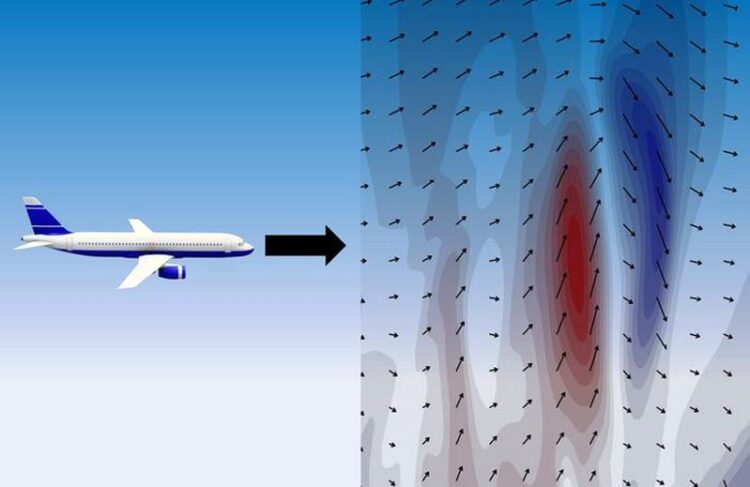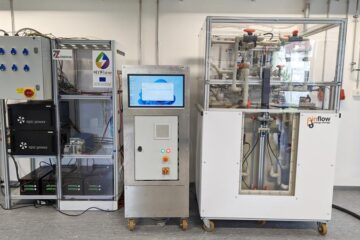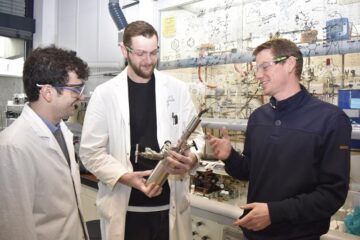Supercomputer used to simulate winds that cause clear air turbulence

Red and blue areas show wind speed differences within the turbulence caused by Kelvin–Helmholtz instability
Credit: Ryoichi Yoshimura
A research group from Nagoya University has accurately simulated air turbulence occurring on clear days around Tokyo using Japan’s fastest supercomputer. They then compared their findings with flight data to create a more accurate predictive model. The research was reported in the journal Geophysical Research Letters.
Although air turbulence is usually associated with bad weather, an airplane cabin can shake violently even on a sunny and cloudless day. Known as clear air turbulence (CAT), these turbulent air movements can occur in the absence of any visible clouds or other atmospheric disturbances. Although the exact mechanisms that cause CAT are not fully understood, it is believed to be primarily driven by wind shear and atmospheric instability.
CAT poses a high risk to aviation safety. The sudden turbulence on an otherwise calm day can lead to passenger and crew member injuries, aircraft damage, and disruptions to flight operations. Pilots rely on reports from other aircraft, weather radar, and atmospheric models to anticipate and avoid areas of potential turbulence. However, since CAT shows no visible indicators, such as clouds or storms, it is particularly challenging to detect and forecast.
As winds swirl and circulate creating sudden changes in airflow, eddies are created that can shake an aircraft. Therefore, to better understand CAT, scientists model it using large-eddy simulation (LES), a computational fluid dynamics technique used to simulate these turbulent flows. However, despite its importance to research on air turbulence, one of the greatest challenges of LES is the computational cost. Simulating the complex interactions involved in LES requires high levels of computing power.
To elaborately simulate the process of turbulence generation using high-resolution LES, the research group from Nagoya University turned to an exascale computer called the Fugaku supercomputer. It is a high-performance computing system, currently ranked as the world’s second fastest supercomputer.
Using Fugaku’s immense computational power, Dr. Ryoichi Yoshimura of Nagoya University in collaboration with Dr. Junshi Ito and others at Tohoku University, performed an ultra-high-resolution simulation of the CAT above Tokyo’s Haneda airport in winter caused by low pressure and a nearby mountain range.
They found that the wind speed disturbance was caused by the collapse of the Kelvin-Helmholtz instability wave, a specific type of instability that occurs the interface between two layers of air with different velocities. As one layer has higher velocity than the other, it creates a wave-like effect as it pulls at the lower velocity layer. As the atmospheric waves grow from the west and collapse in the east, this phenomenon creates several fine vortices, creating turbulence.
After making their computations, the group needed to confirm whether their simulated vortices were consistent with real-world data. “Around Tokyo, there is a lot of observational data available to validate our results,” said Yoshimura. “There are many airplanes flying over the airports, which results in many reports of turbulence and the intensity of shaking. Atmospheric observations by a balloon near Tokyo were also used. The shaking data recorded at that time was used to show that the calculations were valid.”
“The results of this research should lead to a deeper understanding of the principle and mechanism of turbulence generation by high-resolution simulation and allow us to investigate the effects of turbulence on airplanes in more detail,” said Yoshimura. “Since significant turbulence has been shown to occur in the limited 3D region, routing without flying in the region is possible by adjusting flight levels if the presence of active turbulence is known in advance. LES would provide a smart way of flying by providing more accurate turbulence forecasts and real-time prediction.”
Journal: Geophysical Research Letters
DOI: 10.1029/2022GL101286
Method of Research: Computational simulation/modeling
Article Title: Clear Air Turbulence Resolved by Numerical Weather Prediction Model Validated by Onboard and Virtual Flight Data
Article Publication Date: 21-Jun-2023
Media Contact
Matthew Coslett
Nagoya University
kouho-en@adm.nagoya-u.ac.jp
Original Source
https://www.nagoya-u.ac.jp/researchinfo/result-en/index.html
All latest news from the category: Earth Sciences
Earth Sciences (also referred to as Geosciences), which deals with basic issues surrounding our planet, plays a vital role in the area of energy and raw materials supply.
Earth Sciences comprises subjects such as geology, geography, geological informatics, paleontology, mineralogy, petrography, crystallography, geophysics, geodesy, glaciology, cartography, photogrammetry, meteorology and seismology, early-warning systems, earthquake research and polar research.
Newest articles

Efficient, sustainable and cost-effective hybrid energy storage system for modern power grids
EU project HyFlow: Over three years of research, the consortium of the EU project HyFlow has successfully developed a highly efficient, sustainable, and cost-effective hybrid energy storage system (HESS) that…

Safer alternative for an explosive reaction
The chemical industry has been using a reaction with explosive chemicals for over 100 years – now Mülheim scientists have discovered a safer alternative. The Ritter Group of the Max…

How immune cells communicate to fight viruses
Chemokines are signalling proteins that orchestrate the interaction of immune cells against pathogens and tumours. To understand this complex network, various techniques have been developed to identify chemokine-producing cells. However,…





















